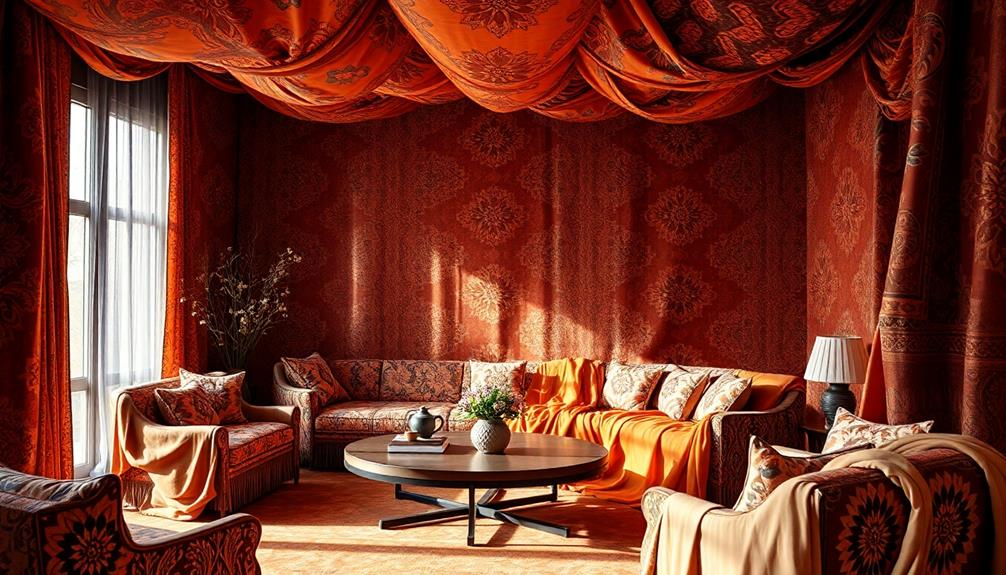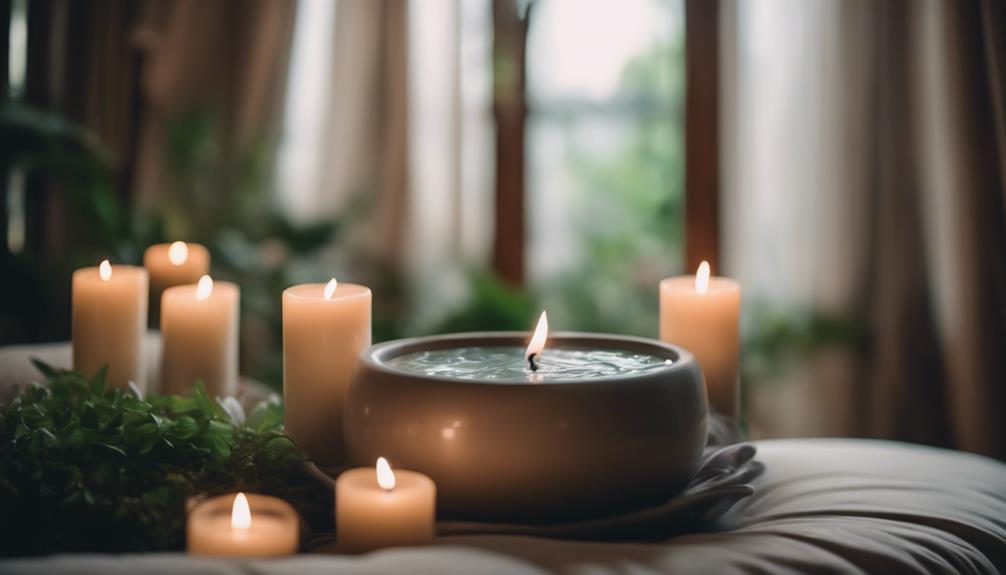Batik patterns can effortlessly bring beauty and balance to any room. These vibrant textiles showcase intricate designs and rich colors, enhancing your space instantly. Choose from floral motifs for a soft touch or geometric patterns for a modern vibe; both breathe new life into your decor. By combining batik with solid colors, you create a harmonious atmosphere that feels cohesive. Accent pieces, like throw pillows or wall hangings, serve as stunning focal points, adding character and cultural richness. You'll discover even more ways to incorporate these breathtaking designs into your home's ambiance.
Key Takeaways
- Choose vibrant batik patterns with rich color combinations to create stunning focal points that enhance any room's aesthetic appeal.
- Incorporate nature-inspired motifs, like floral designs, to promote tranquility and balance in spaces with neutral furnishings.
- Use geometric patterns for a modern touch, providing visual interest while maintaining harmony with other decor elements.
- Select batik textiles in a cohesive color palette to streamline decor and ensure all elements complement each other.
- Utilize batik wall hangings as eye-catching accents, showcasing intricate designs that reflect personal style and cultural significance.
The Art of Batik
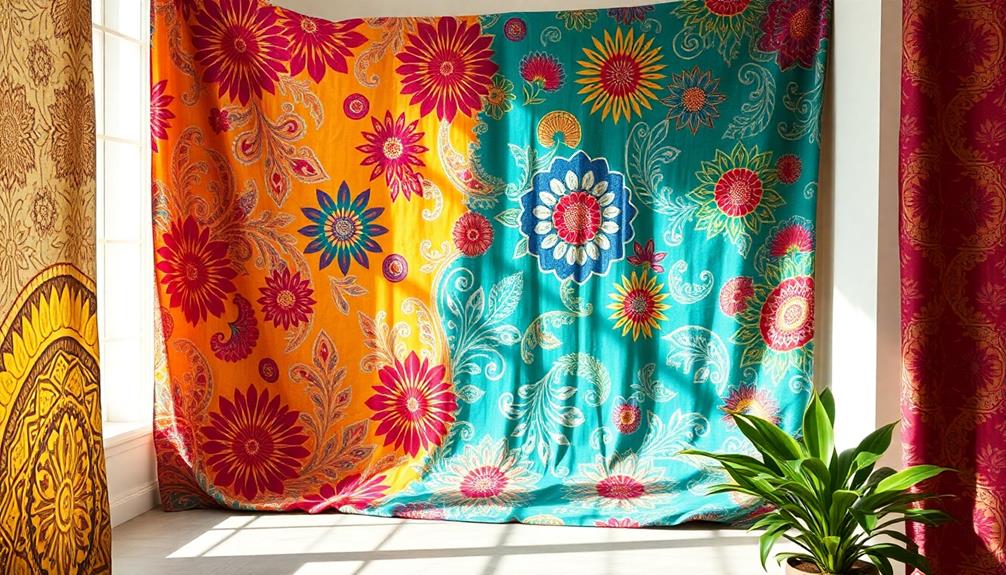
Batik is a fascinating art form that combines creativity and tradition, enchanting those who appreciate its beauty. Originating from Indonesia, the art of batik employs a wax-resist dyeing technique to create intricate patterns and vibrant colors.
You'll find that the design process is both meticulous and rewarding. It starts with applying hot wax to fabric, which protects specific areas from dye. Once dyed, the fabric reveals stunning designs that showcase the artisan's skill and reflects the rich Indonesian cultural heritage exemplified in other forms like Indonesian decor masks.
Batik fabrics can be crafted from various materials, with cotton being the most popular choice for its affordability and versatility. Many regions attach cultural significance to their patterns and colors, with each design often symbolizing local traditions and histories. This makes the art of batik not just an aesthetic choice but also a meaningful one.
Moreover, batik isn't limited to clothing. You can incorporate this beautiful art into your home decor through quilts, wall hangings, and other items. By choosing batik patterns, you can infuse your space with beauty and balance, making it a unique reflection of your appreciation for art and culture.
Popular Batik Patterns

When you explore popular batik patterns, you'll notice how vibrant color combinations can transform your space. These intricate designs, ranging from geometric shapes to floral motifs, offer a rich cultural aesthetic that can easily enhance any room. Incorporating traditional fabrics or even batik-inspired prints into your furniture, curtains, or wall art can create an inviting, warm atmosphere. If you’re looking for inspiration, there’s no shortage of batik home decor ideas available to help you add a personal and artistic touch to your living space.
The unique textural elements in these designs add depth and character, making each piece stand out.
These handcrafted textiles not only enhance visual appeal but also reflect Indonesia's cultural heritage.
Whether you're looking for a bold statement or subtle accent, batik patterns offer something special for your home decor.
Vibrant Color Combinations
How can vibrant color combinations transform your home decor? By incorporating popular batik patterns, you can create a stunning visual impact that enhances any room. Batik fabrics often showcase deep blues paired with bright yellows, creating a striking contrast that draws the eye.
These vibrant color combinations, like rich reds, earthy greens, and vivid purples, offer versatility, allowing you to pair them with various interior design themes. Additionally, you can find unique pieces that reflect traditional artistry inspired by Indonesian decor, offering a rich cultural touch to your space.
When you choose batik patterns, look for those with intricate floral and geometric motifs. These designs make perfect accent pieces, whether as throw pillows, wall hangings, or even table runners.
Plus, many batik fabrics are hand-dyed, ensuring each piece boasts unique variations in color saturation and pattern, adding an artisanal touch to your decor.
To achieve a balanced look, try combining lighter shades with darker tones. This approach creates harmony and keeps the space inviting without overwhelming the senses.
Embracing vibrant color combinations in your home not only showcases your style but also brings beauty and balance to every corner. So go ahead, let batik patterns elevate your living space!
Unique Textural Elements
Throughout history, unique textural elements in batik patterns have captivated designers and homeowners alike. The intricate designs and vibrant colors of batik not only enhance aesthetic appeal but also bring a sense of cultural artistry into your space.
Additionally, the rich cultural heritage represented in these patterns reflects the diverse traditions of Indonesia, similar to the storytelling aspect of Indonesian decor masks. One of the standout features of batik is the wax-resist dyeing technique, which creates rich, layered effects that add depth to fabric surfaces.
Here are three popular batik patterns showcasing unique textural elements:
- Floral Motifs: These patterns often feature delicate flowers that add a touch of nature's beauty, perfect for softening any room.
- Geometric Designs: Bold shapes and lines create a modern look, ideal for contemporary spaces seeking a striking visual element.
- Abstract Patterns: With their fluid forms and unexpected colors, these designs inject creativity and whimsy, making them versatile for various decor styles.
The durability and versatility of batik fabrics allow you to use them in everything from quilts to upholstery.
Plus, the natural dyes create unique color variations, ensuring every piece is one-of-a-kind. Embrace these unique textural elements to elevate your home's decor!
Choosing the Right Colors
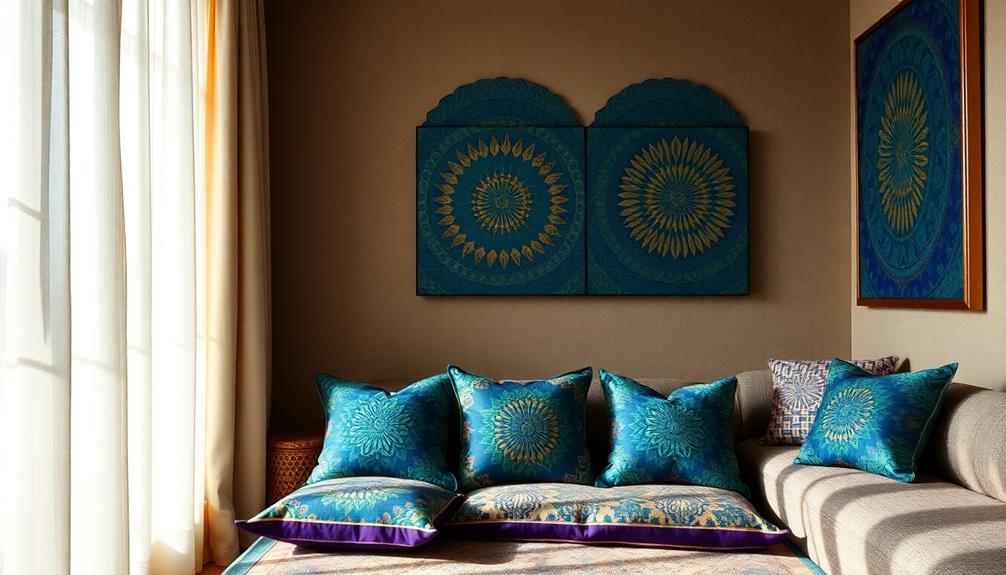
When you choose colors for your batik patterns, think about how they'll create harmony and balance in your space.
Emphasizing natural materials and earth tones can enhance the calming effect of your decor, while incorporating traditional motifs and patterns can add a unique cultural touch.
Consider using contrasting shades to add visual interest while also drawing on seasonal inspirations to keep your decor fresh.
Color Harmony Techniques
Selecting the right colors for your batik patterns can transform your home decor, creating a space that feels harmonious and inviting.
To effectively utilize color harmony techniques, consider these strategies as you're going to add beauty and balance to your rooms:
1. Balanced Palette: Incorporate a mix of light, medium, and dark shades. This approach creates depth and visual interest, making your batik patterns stand out.
Additionally, integrating elements from traditional Indonesian style home decor can enhance the overall aesthetic of your space.
2. Complementary Colors: Use the color wheel to find pairs of opposite colors. This not only enhances vibrancy but also adds energy to your designs, making them truly pop.
3. Mood Considerations: Think about the atmosphere you want. Warm colors like reds and oranges foster a cozy environment, while cool colors such as blues and greens evoke calmness.
Contrast and Balance
Creating a visually appealing space involves understanding how contrast and balance work together in your batik patterns. When selecting your designs, aim for a harmonious balance by combining contrasting colors. Pair warm hues like reds and oranges with cool tones such as blues and greens to create visual interest in any room.
For inspiration, reflect on exploring unique decor items that incorporate vibrant colors and patterns.
Using a light background fabric with vibrant batik prints can enhance your overall design, allowing the colors to pop while maintaining balance. Incorporate darker batik fabrics as accents or borders; they add depth and richness, grounding your design and creating a cohesive look.
Don't forget to take into account the scale of your prints. Smaller patterns can beautifully complement larger designs, providing that essential contrast and balance that draws the eye throughout the space.
Lastly, keep in mind the principles of color theory. Utilizing complementary and analogous color schemes guarantees all batik elements work together harmoniously in your decor.
Seasonal Color Inspirations
As the seasons change, so can your home's color palette, and seasonal color inspirations can breathe new life into your decor.
Embracing the hues that resonate with each season not only enhances your space but also reflects the mood you want to create.
Traditional Indonesian housing often features intricate designs that can inspire your own decor choices, showcasing how traditional architectural styles can influence color selection.
Here are three ways to incorporate seasonal color inspirations through batik patterns:
- Autumn Warmth: Use rich oranges and yellows in batik designs to create a cozy atmosphere, perfect for fall gatherings.
- Spring Renewal: Opt for cool blues and greens to evoke a revitalizing vibe, making your space feel light and airy as nature awakens.
- Soothing Pastels: Incorporate soft pastels in your bedroom or meditation area to promote tranquility and relaxation.
Batik in Home Decor
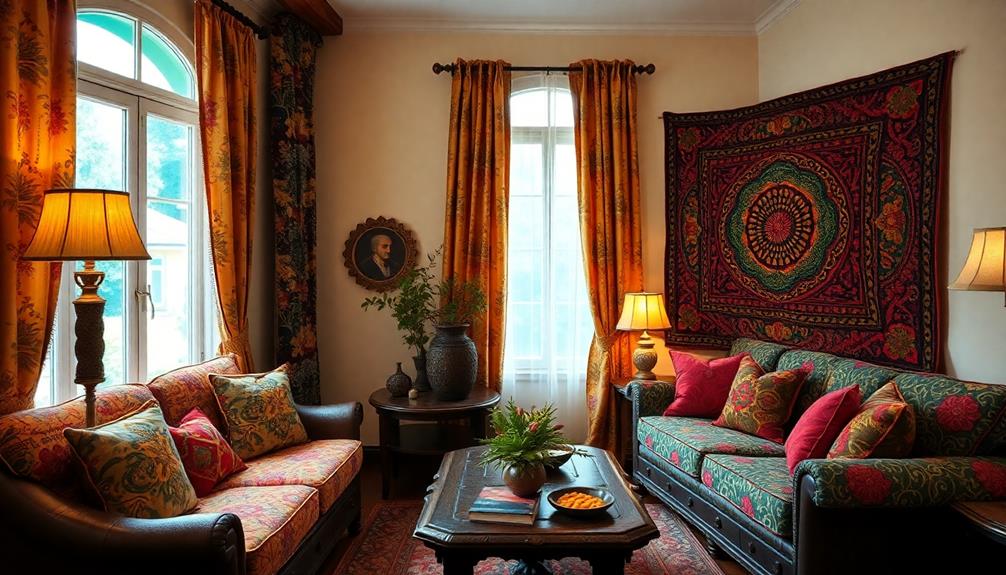
Batik in home decor adds a vibrant and artistic touch that can transform any space. You can easily incorporate batik fabrics into your home through stunning throw pillows, curtains, and table runners, all of which infuse color and personality into your rooms.
Additionally, using traditional motifs and patterns enhances the cultural significance of your decor, making it more meaningful. Batik quilts not only bring warmth but also serve as conversation starters, showcasing unique designs and cultural significance.
Using batik in wall art, like framed pieces or fabric wall hangings, creates striking focal points that add depth and visual interest to your decor. The nature-inspired motifs often found in batik patterns promote a sense of tranquility, especially when paired with neutral furnishings, enhancing the overall balance of your environment.
Incorporating elements like intricate fabrics can also elevate the aesthetic appeal of your space.
Don't forget about upholstery or accent furniture! Choosing batik for these elements elevates your room's aesthetic, offering a rich tapestry of color and pattern that complements both modern and traditional styles.
With batik in home decor, you're not just decorating; you're creating a vibrant atmosphere that tells a story and invites appreciation from everyone who enters your space.
Incorporating Batik Textiles
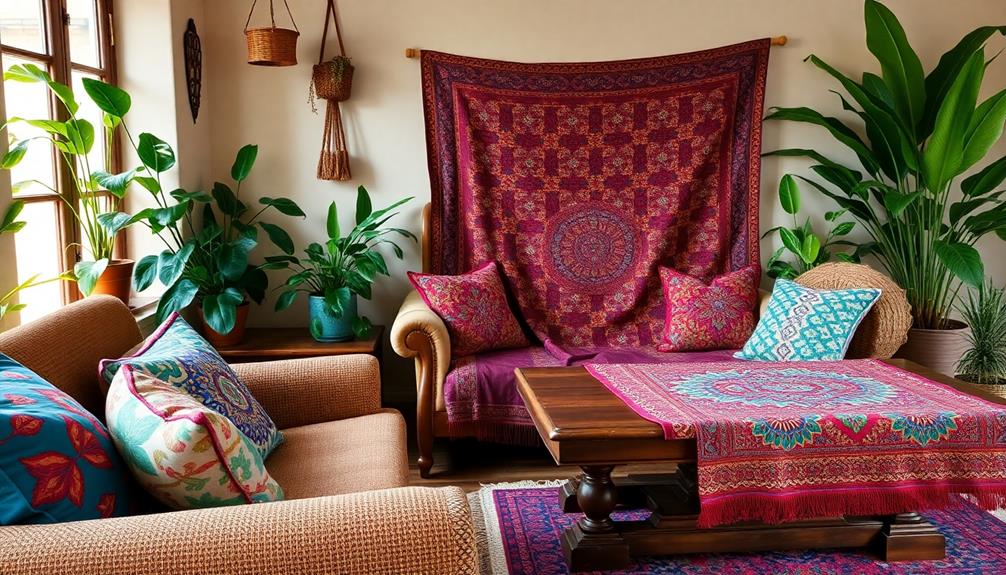
When incorporating batik textiles into your home decor, start by selecting a color palette that complements the rich hues of the fabrics.
Consider blending these textiles with pieces from Mahallati Interiors that specialize in tropical-themed luxury designs.
Use design placement techniques to highlight the intricate patterns without overcrowding your space.
Balancing batik with solid or subtly patterned fabrics will enhance the overall aesthetic while allowing these unique textiles to shine.
Color Palette Selection
Incorporating batik textiles into your home decor can instantly elevate your space with vibrant colors and intricate patterns.
To achieve an effective color palette selection, consider the following tips:
- Balance Warm and Cool Tones: Combine warm hues like reds and oranges with cool colors like blues and greens. This creates harmony and visual interest in your room.
- Pair with Solid Colors: Use solid colors to accentuate the unique patterns of your batik textiles. This approach helps keep the design from becoming overwhelming, allowing the batik to shine.
- Limit Your Palette: Choose a limited color palette derived from the batik fabric. This streamlines your decor and creates a cohesive look throughout the room.
Design Placement Techniques
The vibrant charm of batik textiles can transform any space, but their placement is key to maximizing their impact. When you incorporate batik into your quilt designs, start with a light background fabric. This allows the vibrant colors and intricate patterns of the batik to stand out effectively.
To create balance and prevent visual overwhelm, pair batik prints with solid fabrics or small-scale patterns, ensuring the dynamic designs shine through.
Utilize design placement techniques by strategically placing batik textiles alongside complementary colors. This enhances the overall energy and visual interest of your quilt. Experiment with arranging batik pieces to create a focal point, drawing attention to the unique characteristics of each print.
For a cohesive look, incorporate batik textiles in larger blocks or as borders. This approach grounds your design while allowing the intricate details of the batik to be appreciated.
Batik Wall Hangings

Batik wall hangings bring together artistry and tradition, making them a stunning addition to your home decor. These pieces are created using a traditional wax-resist dyeing technique, resulting in intricate patterns and vibrant colors that enhance any room.
The unique designs often feature motifs inspired by nature, cultural symbols, or geometric shapes, allowing them to fit various interior styles effortlessly.
Here are three reasons why batik wall hangings can transform your space:
- Versatility: Available in various sizes, batik wall hangings can act as large statement pieces or smaller decorative accents, perfect for any wall space.
- Durability: Made from high-quality cotton or silk, these wall hangings guarantee a luxurious feel and long-lasting beauty in your home.
- Focal Point: Incorporating a batik wall hanging can create an eye-catching focal point, adding beauty and balance while showcasing your personal style and cultural appreciation.
Whether you choose a dynamic quilt design or a simple pattern, batik wall hangings are sure to look amazing and elevate the ambiance of your home.
Furniture Upholstery Ideas
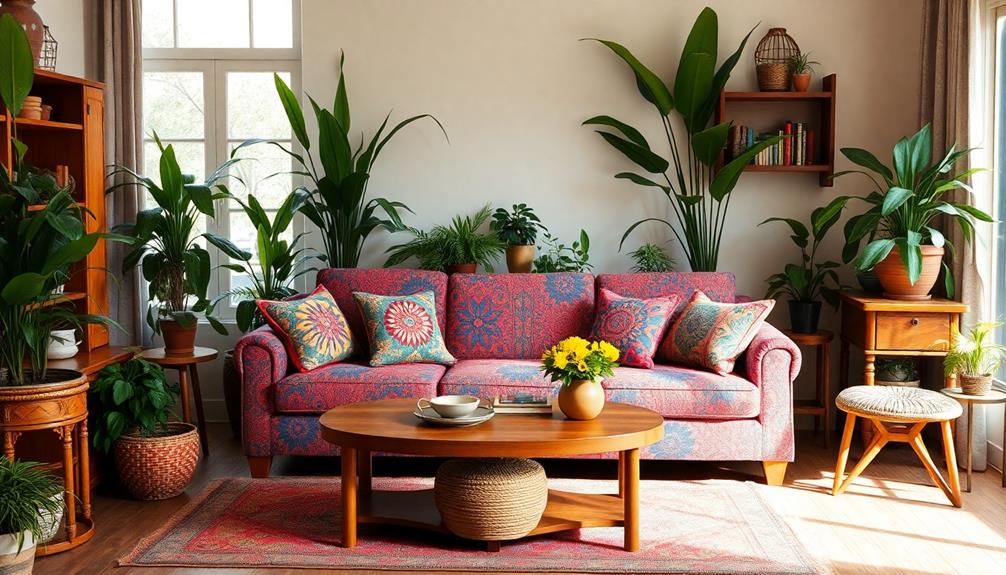
Transforming your furniture with batik patterns can instantly elevate your home decor. These vibrant, intricate designs add a unique touch to upholstery, making your pieces stand out as focal points in any room.
For accent chairs or throw pillows, consider using batik fabric with bold geometric designs. This choice creates visual interest and a contemporary vibe, enhancing your living space.
When you're upholstering larger items like sofas, opt for batik patterns with a more subdued color palette. This approach maintains balance and harmony within your overall decor.
Mixing batik upholstery with neutral or solid-colored furniture enhances aesthetic appeal, allowing the batik patterns to serve as a stylish contrast without overwhelming the space.
For a cohesive look, pair batik-upholstered furniture with coordinating batik accessories, such as curtains or table runners. This creates a unified theme throughout the room, making your decor feel intentional and complete.
Embracing batik patterns in your furniture upholstery not only elevates your style but also infuses your space with cultural richness and artistic flair.
Accent Pieces and Accessories
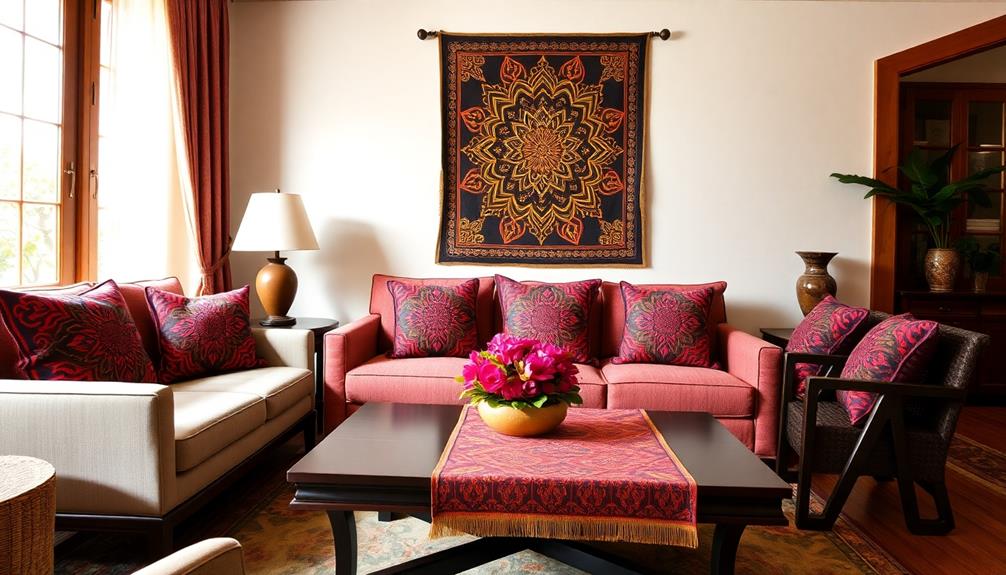
Adding batik accent pieces and accessories to your home is an instant way to brighten up your decor. These vibrant, intricately patterned items not only enhance the aesthetic but also introduce a touch of cultural artistry. Incorporating batik elements can give you a little boost in style and warmth, setting the perfect atmosphere for any room.
Here are three fantastic ideas to contemplate:
- Throw Pillows: Use batik-patterned throw pillows on your sofa or bed to infuse rich colors and create a cozy vibe.
- Table Runners: A batik table runner can serve as a striking focal point on your dining table, showcasing unique designs while protecting your surfaces.
- Decorative Vases: Fill batik decorative vases with fresh flowers or dried arrangements. Their intricate motifs will draw attention and complement other decor.
Combining these batik accessories with solid-colored furniture can create a cohesive look.
You can also mix them with other textiles like woven or knitted items, giving you a little diversity that maintains harmony in your design theme.
Maintenance and Care Tips

To keep your batik accent pieces looking vibrant and fresh, it's important to follow some straightforward maintenance and care tips.
First, avoid direct sunlight exposure, as it can cause the beautiful colors to fade over time. Regularly check for any loose threads or fraying edges, and promptly repair them to prevent further damage to the fabric.
When it comes to cleaning, hand wash your batik fabrics in cold water with a mild detergent. This preserves the intricate designs and prevents color bleeding, guaranteeing your pieces remain stunning.
If you need to iron your batik items, do so on a low to medium setting, using a pressing cloth to protect the fabric and maintain its texture.
Storage is also vital for maintenance. Keep your batik quilts and textiles in a cool, dry place, ideally rolled rather than folded. This minimizes creasing and helps maintain their shape.
Crafting With Batik Fabrics

Crafting with batik fabrics opens up a world of vibrant possibilities for your home decor projects.
Known for their intricate patterns and rich colors, batik fabrics can elevate your space with unique artistic flair.
I'm going to show you how to incorporate these stunning textiles into your creations effectively.
Here are three great ideas for using batik fabrics:
- Quilts: Combine batik pieces with solid colors to create beautiful quilts. The batik patterns can serve as focal points, adding depth and character to your design.
- Cushions and Pillows: Make stylish cushion covers or throw pillows using batik fabrics. Pair them with subtle prints or solid colors to keep the overall look balanced.
- Table Runners: Craft a striking table runner that showcases the vibrant colors of batik. This can serve as a stunning centerpiece for your dining table.
Frequently Asked Questions
What Is the Most Famous Batik Pattern?
The most famous batik pattern is the "Parang." Its wave-like design symbolizes life's continuous flow. You'll find its beauty in various textiles, showcasing Indonesia's rich cultural heritage and artistic mastery through intricate wax-resist dyeing techniques.
What Are the 5 Major Types of Batik Design?
Imagine a tapestry woven with stories; that's batik. You've got Traditional Batik, Modern Batik, Batik Tulis, Batik Cap, and Batik Kombinasi. Each type tells a unique tale, inviting you into its colorful world.
What Are the Three Main Elements of Batik Pattern?
The three main elements of batik patterns are wax, dye, and fabric. You apply wax to create designs, then dye the fabric, allowing the wax to resist the dye, resulting in unique, intricate patterns.
What Does the Batik Symbolize?
Batik symbolizes cultural heritage, embodying stories and beliefs through intricate designs. It represents life's dualities—creation and destruction—while promoting unity and diversity, reflecting the interconnectedness of communities that embrace this beautiful art form.
Conclusion
Embracing batik patterns in your home decor can transform your space into a vibrant oasis of beauty and balance. With their rich history and stunning designs, these textiles are more than just fabric; they're a statement that can elevate any room to extraordinary heights. So, don't hesitate to incorporate batik into your furnishings and accents. With a little care, you'll create an inviting atmosphere that's not just stylish but also steeped in culture and artistry.
